This is a random photo I got an American Tree Sparrow on Friday.

I wonder how much longer I will see these guys and how soon they will be replace by incoming field sparrows?
Birdchick Blog
This is a random photo I got an American Tree Sparrow on Friday.

I wonder how much longer I will see these guys and how soon they will be replace by incoming field sparrows?
 Ah, Spring, you did just what I thought you would do. You pushed it all the way to the edge with your warmth, even giving me 60 degree days. Yesterday, I biked to a meeting and got a slight tan for my folly of a lack of sunscreen. Each day on the bike trail gave a new migrant. Monday it was just juncos practicing their territory song. Tuesday a few groggy red-winged blackbirds showed up (like the bird above), Wednesday you gave me bluebirds around my beehives--all so wonderful. And today, you give us back the cold. Even the red-winged blackbirds seemed to be singing, "I came back for this?!?"
Ah, Spring, you did just what I thought you would do. You pushed it all the way to the edge with your warmth, even giving me 60 degree days. Yesterday, I biked to a meeting and got a slight tan for my folly of a lack of sunscreen. Each day on the bike trail gave a new migrant. Monday it was just juncos practicing their territory song. Tuesday a few groggy red-winged blackbirds showed up (like the bird above), Wednesday you gave me bluebirds around my beehives--all so wonderful. And today, you give us back the cold. Even the red-winged blackbirds seemed to be singing, "I came back for this?!?"

I was out today with my buddy who runs Avian Images and after the warm temperatures of earlier this week, we were hoping for a warm day at Wood Lake Nature Center. We didn't get it. But it was still nice to see red-winged blackbirds here, a sure sign of spring--much better than the confusing robins that we see all winter.
This blog post is not only an update for those curious about the going's on, but also to serve as notes for how we prep the hives this fall. What's nice about a blog is that is kind of a nice notebook. Also, Mr. Neil would like an update on our bees while he is traveling the world. After last year when our bees were okay in February and then dying in March, moisture appeared to be part of the problem, so we tried a variety of solutions. One being Mr. Neil's groundskeeper named Hans went out and cleared snow away from the bottom entrances. We also had him go ahead and remove the insulation, last year was a colder winter and we left it on longer. But the bees had been quite active and it's been so warm (it hit 60 degrees yesterday) that Hans took it off last week. We didn't put the insulation on until late last fall, they should be able to take it if we dip down into the twenties again.
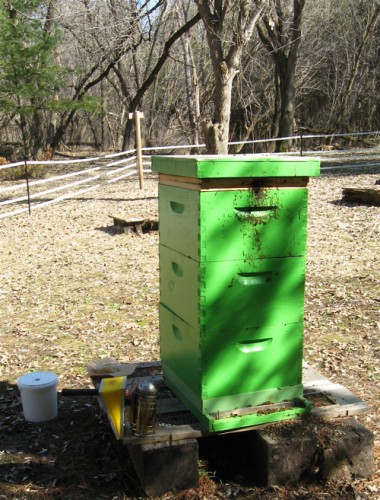
The green hive was three deep brood boxes this winter which is what I was taught we should do at the University of Minnesota's beekeeping short course. She's been fairly noisy all winter. The bees had taken advantage of the warm days and pooped up a storm (they don't poop in the hive so hold it up all winter and then let her rip on warm spring days). We used a wooden entrance reducer on her--to control the flow of air from below and prevent mice from entering the hive. She also had a piece of board on top, above the ceiling to absorb moisture during the winter. It appeared to have worked, there was a little moisture on the board, a little mold, but none on the ceiling or top of the brood box itself.

This hive also has a slatted rack which is supposed to discourage swarming. Also a beekeeper told me that it's somehow supposed to aid in ventilation. I'm not sure, I think it's one of those things where a beekeeper noticed less moisture in the hive when they have had it in there. I took out the entrance reducer and used my hive tool to clear out some of the dead bees at the bottom to help with air flow and give the girls more room to work. The bodies were wet, I cleared out the bee pieces until a few live workers flew out from the bottom. There was a nice, noisy active cluster of bees at the top of the hive. I placed a feeder pail of nectar on top and added a pollen patty to help get them trough the next couple of weeks. I tweaked all the pollen patties this time with a little actual honey from our stores. I also brought each hive a piece of comb honey, more for my own benefit than anything else, kind of like a hive warming present.
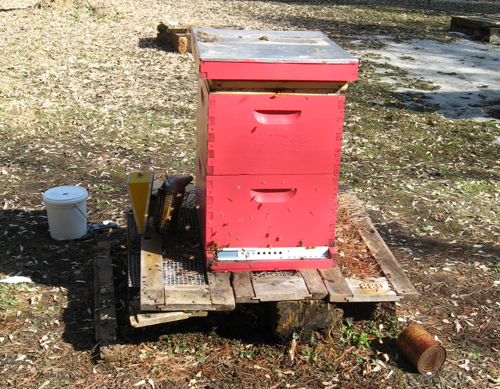
This was a hive I did not expect to survive the winter. She swarmed late in the summer last and I let her do it-- no heroic measures to stop it, even though I thought it a bad move on her part. She went into the winter with just two brood boxes of food and a very small cluster. Some beekeepers do keep their hives down to a 2 box system in winter--even our neck of the woods so she had a chance. She was one of the most active hives I visited yesterday. The green hive had the most workers moving in and out of the entrance, this one had the second largest highway going. I even took some video down by her opening at the metal entrance reducer. If you watch at the bottom left at the beginning you might notice a worker removing a dead body:
[youtube]http://www.youtube.com/watch?v=ExVV-pN1cNA[/youtube]
Impressive activity! I left on her entrance reducer because the bees seemed to be getting out at the bottom and top easily. Mice are still somewhat of an issue but the reducer will probably come off in early April if the weather holds.
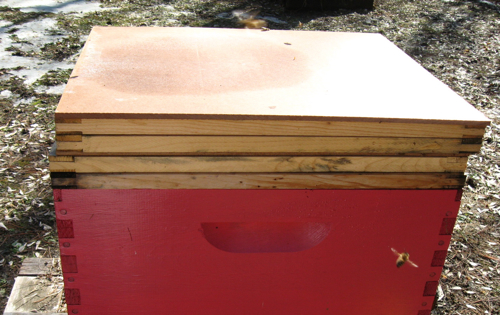
This hive does not have a slatted rack on the bottom but has four inner covers on the top and the moisture board. If you look at the board on top--it has a wet spot. I'd say it did it's job rather well. The ceilings were dry inside this hive which I think aided in her survival.
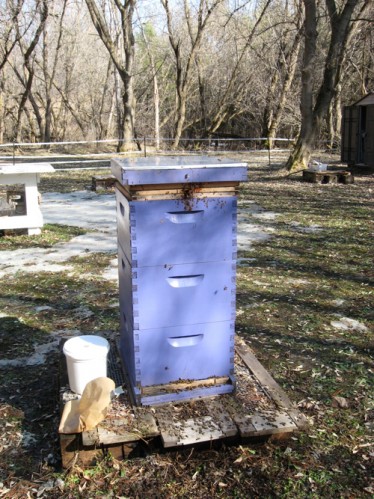
The purple hive was a wee bit quieter but still active. She went into the winter with three deep brood boxes, moisture board, double ceilings but no slatted bottom.
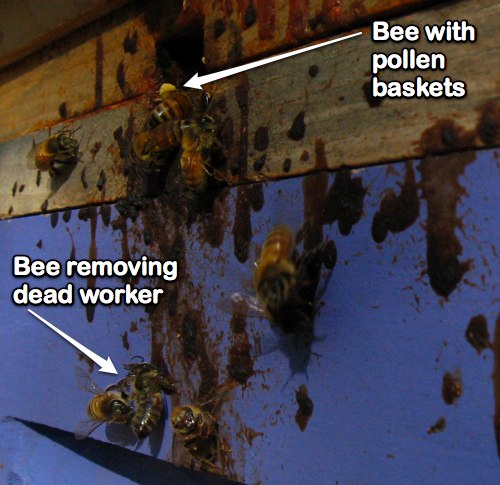
The workers were not coming out of the bottom, but using the top hole to poop, remove some dead bees and if you look closely you can see a forager returning with some yellow pollen baskets!
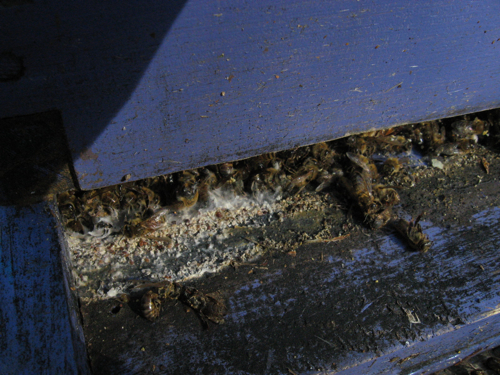 When I removed the entrance reducer, some of the dead, wet bees at the entrance had grown some fungus. It was just at the entrance and scraped out piles of dead bees from the bottom until a few live ones flew out. There was a good ball of bees at the top and they were very excited about the feeder pail and pollen patty.
When I removed the entrance reducer, some of the dead, wet bees at the entrance had grown some fungus. It was just at the entrance and scraped out piles of dead bees from the bottom until a few live ones flew out. There was a good ball of bees at the top and they were very excited about the feeder pail and pollen patty.
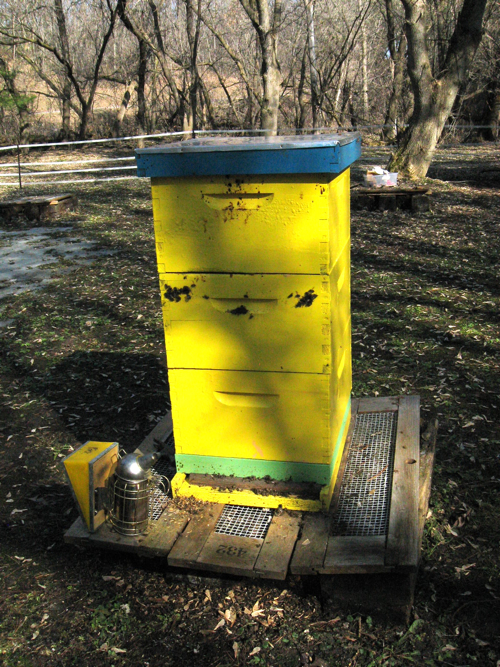
I wasn't sure what to expect of this hive. She'd been fairly quiet all winter. You had to really press your ear up to the insulation to hear anything. Her exit hole at the top of the hive was smaller than the others (barely enough room for one bee to come out and no one ever seemed to come out of the bottom. She had three deep brood boxes, a wooden entrance reducer, a slotted bottom and a moisture board. Bees took turns coming in and out of the top entrance. I opened the top and she was very lively. I put up the feeder pail and pollen patty. You can see a video here (and see a worker come in with loaded pollen baskets while the others nom the feeder pail and nom nom nom the pollen patty.
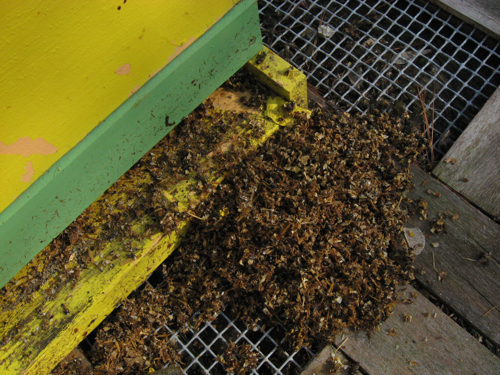
After I removed the entrance reducer and started to scrape out debris, I couldn't help but notice that there were very few bee parts and an awful lot of wood shavings. This did not look good. I had a suspicion of what was going down--a mouse had moved into the hive for the winter. Bastard! The bees had a good harmonious hum going and this was a three deep box. I wondered if maybe the mouse had kept to the bottom while the bees were on top? Was this hive through or could it be saved? I had no choice, I had to open her up.
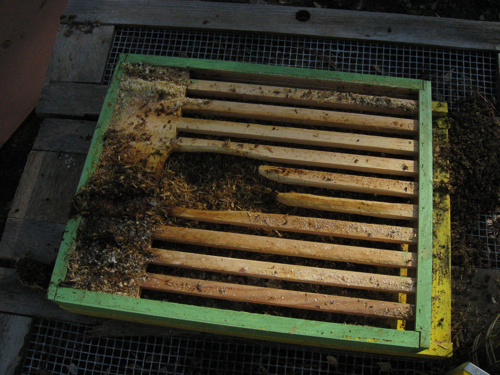
The mouse did not chew up from the base, it looked like it squeeze right through the tiny hole left by the wooden entrance reducer. Then chewed through the slatted bottom and made its nest there. The mouse worked it's way into the bottom brood box and ate quite a bit of the honey and wax, however it did not appear to have gone up into the top two brood boxes and there was still some food left there.
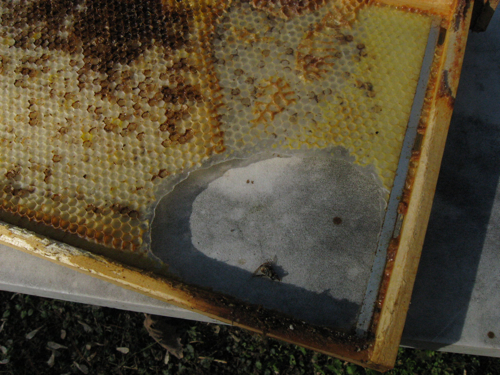
The mouse had chewed into the wax foundation of some of the bottom frames (hope it got a good tummy ache). Looking at photos of other mice in beehive stories, this is typically where the mouse builds the nest. Did this mouse get interrupted? I scraped out the bottom board and found no mouse--not even a propolis covered mouse mummy.
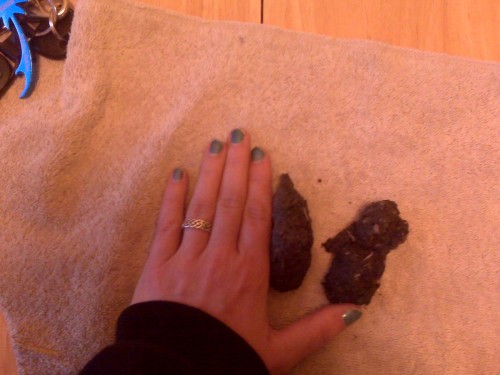
I did find a couple of ginormous owl pellets near the hives. Perhaps the local great horned owl took care of the mouse for me? Maybe I'll find it's skull when I dissect these?
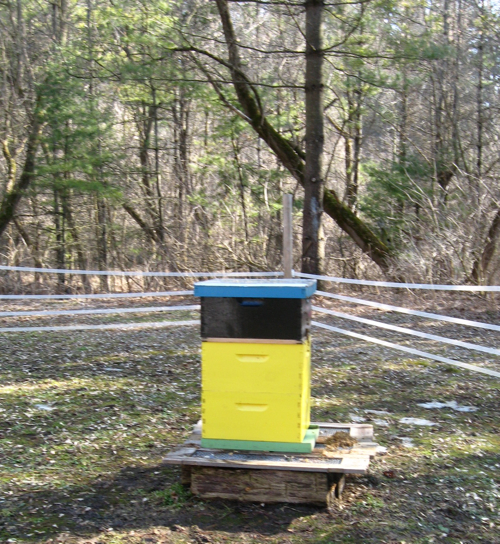
The hive otherwise seemed healthy. I replaced the base board, and removed the bottom box, making this a two brood box hive like the red hive. I put a third and empty box over the feeder pail and pollen patty. I'll be curious to see how this hive does over the next two weeks.
I always knew mice were a possibility and we've had them try and get in the hives before when we find their telltale tracks in the snow leading to the entrances. Usually a well placed snap trap does the trick but this time we didn't see any tracks. The good news is that all four hives are still going and appear to be ready for this summer's honey production. We'll feed all four for as long as they seem to need it.
We're getting 60 degrees around here and I took a moment to check on our hives. It's looking to be a much happier scenario this year than last year when we had only two colonies. We had one that was weak that we thought would die and one that was huge and sounded healthy. By February, all seemed fine. By the end of March, both were about dead. Thanks to the help of Hans and a lucky streak in the weather, we're in a much better situation this year with our four hives. I'll post more later this morning, but here's a teaser from yesterday. I gave the girls some feeder pails and many foragers were out and about already returning with big baskets of pollen. I wondered where they were getting pollen? Trees I suppose. The only flowers I saw blooming were snow bells but I don't think there are enough of those out there to justify the bulbous baskets on my girls' legs. Here's a short video of happy bees on a snowy day:
[youtube]http://www.youtube.com/watch?v=mHjgZb1wEE4[/youtube]
Last week, the interwebs were stoked over the photos of the "Shaft of King Penguins." This week a mostly white puffin has been photographed. I know many of the headlines read that the black penguin was a one in a zillion color morph but they seemed to ignore a smaller black Adelie penguin that Noah Stryker took and posted in his blog in 2008. Meanwhile, Minnesota Bird Nerd has some interesting posts up about a possible chickadee/titmouse hybrid (not unlike the hybrid someone guest blogged here last year). He also has another post up about a possible junco/white-throated sparrow hybrid as well. And if you enjoy MN Bird Nerd's blog and banding, be sure to head out to Lowry Nature Center this Saturday. He and Mark will be publicly banding birds--should be pretty good bird wise with the temperatures changing and warmer weather. Maybe we'll get a fox sparrow? I have to give a program at the St Paul Library on Saturday afternoon, but plan on being at Lowry in the morning for some good birding times.
Forgot to post this earlier.

Thank you Pepsi and Meadowlands for making a Birder Sign. Refreshing change from seeing only Welcome Hunters signs.
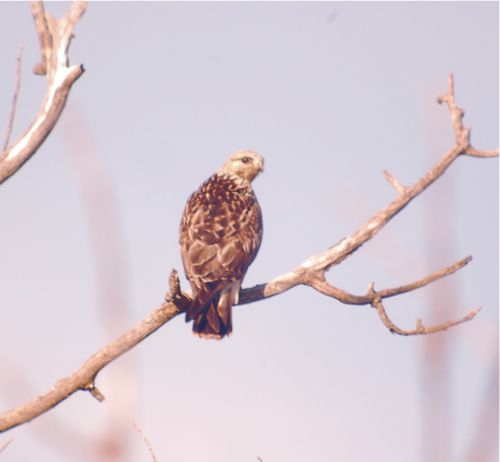 Boy! I needed yesterday. I got one last look at a rough-legged hawk before they head north to their breeding grounds.
Boy! I needed yesterday. I got one last look at a rough-legged hawk before they head north to their breeding grounds.
When Non Birding Bill opened his show MacBeth: The Video Game Remix, we engaged in the traditional opening night party after wards. When I woke up the following Monday morning, I wasn't sure if my body was having a bad reaction to my first long bike ride after winter, I was slightly hungover or coming down with a cold or flu. By the afternoon, it was obvious that I was getting sick. I hoped it would be mild, I had a busy weekend ahead with work and a friend from Michigan was coming to town and requested a Birds and Beers on Saturday night and a trip to Sax Zim Bog on Sunday. I sensibly spent the rest of the week sleeping, watching movies and eating lots of spicy food. Saturday I felt okay and had a terrific time at Merlin's Rest (so good that between it and Daylight Savings Time I managed only 3 hours sleep before leaving for the bog).
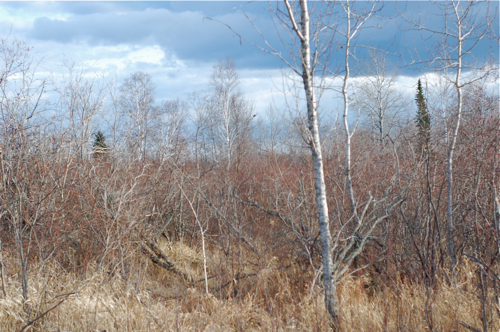
It was such a perfect day at the bog--mostly sunny, blue skies, a few colorful clouds, temperatures in the fifties and most of the snow melted. The sun brought out the color of the bark on the dogwood, grasses and pussy willow. I also had excellent company in the form of BlobbyBirdMan (aka Mark). I wondered if we'd see many sunny signs of spring and we did. Above you might notice a dark lump in a distant bare tree. That was Blobby's lifer porcupine.

I tried to digiscope it as a souvenir for him but the porcupine appeared to be rather lethargic or doing his best impersonation of a sloth. We hoped we would hear ruffed grouse drumming and we did. It was distant, so we walked into the bog a bit, we found a log and sat for a long stretch to listen. About every ten minutes we would hear the tentative drum beating and then accelerate. I've always thought it more of a sound that you feel inside your rather than hear. Mark described it as more of a heart beat type sound. After being sick all week, I treasure the time spent on a log with no talking and natural sounds (periodically broken up by the sound of a distant train or surprisingly close ATV).
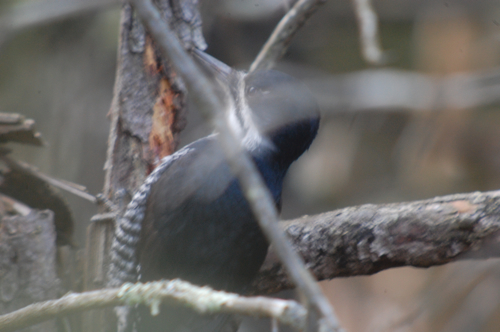
I did get off with a rather dubious start. The first bird I stopped our car for ended up being a starling. But not long after that, I stopped at a spot that looked good for black-backed and three-toed woodpeckers. As soon as I turned the engine off in my car, I heard soft tapping and it wasn't long before Mark got his lifer black-backed woodpecker. We also had a small flock of boreal chickadees show up too.
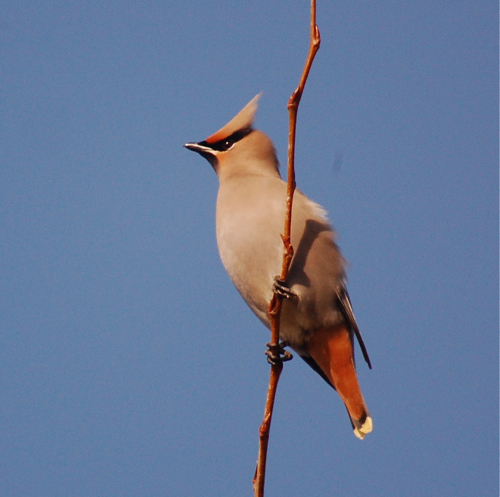
One of Mark's target birds was a bohemian waxwing and we saw several flocks. What was interesting was the very different attitude the birds had compared to last November when winter was just getting underway. Back then they were in large flocks and the birds stayed close together calling with a bit of urgency. The flocks we saw yesterday were very loose and calling but with an easy going frequency.

Some of them even appeared to be setting up pairs. The really exciting thing was the the waxwings weren't eating berries but jumping out into the blue and catching insects! It's warm enough for insects! Whoot! That was also confirmed on the drive home when several large bugs left tacky yellow smudges on my windshield.

There were still good numbers of pine siskins about but we didn't see much in the way of grosbeaks or redpolls. Some of the feeders were coming down in the bog too. The feeders on Blue Spruce road were missing. The home owners said that the pole came down during the melt and broke all the feeders. I asked if they needed some new ones. I figured birders would be willing to donate some since so many of us enjoy the feeders. They said that they get plenty of donations and that they would put them up again next fall.
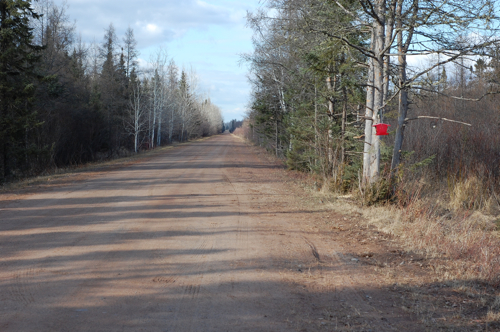
The feeders on Admiral Road were still going only now instead of a big old hunk of deer carcass, there's an actual bird feeder and suet cages. I heard that there had been some complaints from residents in the bog that the deer carcass would attract wolves. I think wolves are in the bog whether deer carcasses are hung or not--I actually saw one there a few years ago crossing the railroad tracks. But if the locals will allow feeders for public enjoyment as long as it's not a deer rib cage, that's a reasonable compromise. It's really nice that there are people willing to maintain public bird feeders in the bog. I know some mornings I don't always want to fill the feeder out the window.
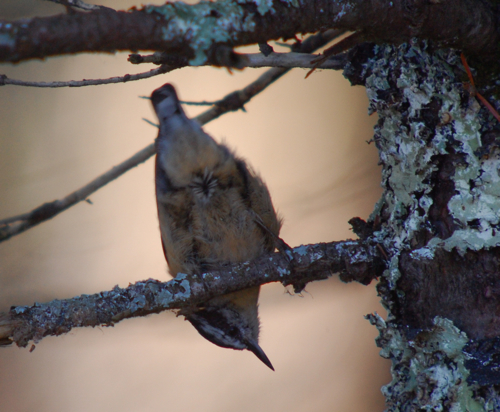
We saw mostly red-breasted nuthatches and black-capped chickadees at the feeder. Some blue jays and some grays also flew in. Red-breasted nuthatches were definitely pairing up. Look at the female red-breasted nuthatch above. By that swollen little cloaca, I'd say she's in them mood for some mating.
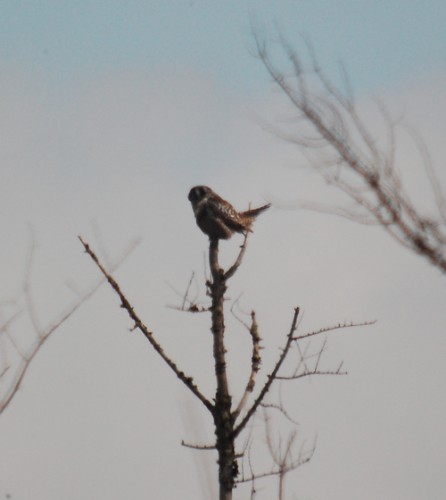
Speaking of mating, Mark spied a distant northern hawk owl and when we pulled over, we briefly saw a larger one beneath it mantling. The larger hawk owl dove lower into the trees and I wondered if we caught the tail end of a food pass between a male and female northern hawk owl? The smaller of the two continued his watch for prey from the tops of snags. We heard a bit of vocalization which is called the "scree yip" on the Cornell Owl CD. It can be used as either an alert to an intruder or during food pass. We were way too far out on the road to be causing it, so perhaps it was related to food passing. I hope they stay and raise a few chicks.
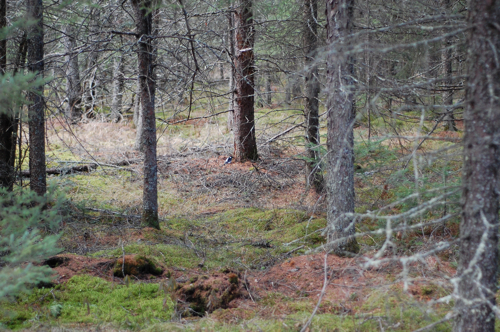
At another stop, we heard a woodpecker quietly working away at some bark and I hoped it would be a three-toed for Mark, I've seen them here before. Alas, it ended up being a hairy woodpecker, but I loved that it gave an excuse to sneak and see the green of the bog. When you look from the outside along the road, it looks like such a dark and foreboding place and inside the light filtered through the trees is a shady green.
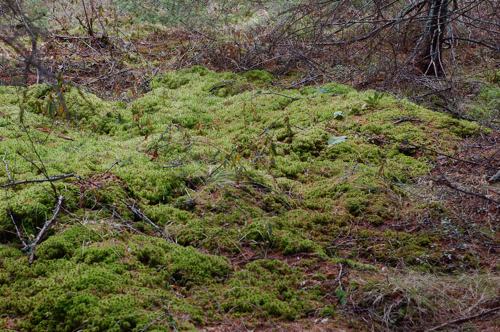
The spongy green floor looked to tempting. I wanted to take off my jacket and lay there for hours, feeling the cool of the green and enjoying the warm air. It almost seemed to say, "Sharon, winter is over for sure, spring and summer is definite in its arrival." But I'm not falling for that siren's song. It's too early in March for me to believe that we will have no more snow. I thought I would take an alternate route on the way home to try for a few species we missed. My navigational system and Google Maps took me to Great River Road. When we were about 6 miles from our destination, we saw an orange sign that read road work was ahead and there was suddenly no pavement. I went a few miles and felt the shifting mud from the melted snow get more unpredictable and said, "I'm not so confident about this road..."
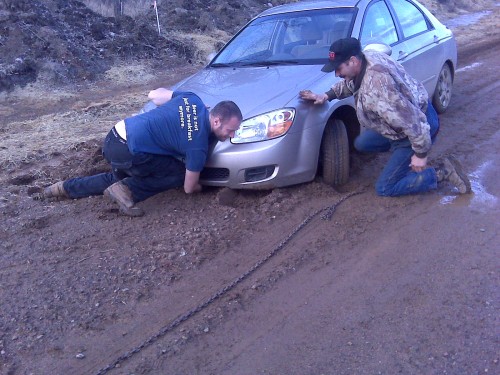
Famous last words! I swerved to the right side and was properly lodged into some mud. DOH! As I started to figure out how to explain my location to AAA, Mark walked to a neighbor who confirmed we were still on the Great River Road and that he's now so house bound, his neighbor down the way has to fetch his mail and drive him to town, his driveway is a mud trap. Mark thought it would be faster to look for this neighbor. We went about a quarter of a mile and their first sing of humans we passed was an old cemetery. I was beginning to worry this was going into urban legend territory and learn that this man hasn't had any neighbors for 30 years. Another half mile we found the neighbor who kindly offered to dislodge my Kia with his truck and gave us a route that would be on higher and drier ground. I owe him a big box of chocolates.
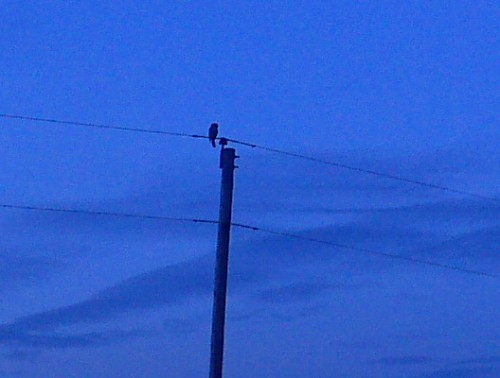
We made it out of the mud before sunset and on our way out we were rewarded with a very close northern hawk owl. It was too dark for digiscoping, but I got a quick photo with my blackberry. All and all it was a great adventure to cap off a week of being sick.
The Aveda Institute is hosting a fundraiser day for Minnesota Audubon on March 28 from 11am - 3pm! The Annual Aveda Midwest Earth Month Cut-a-Thon and Spa-a-Thon at the Aveda Institute Minneapolis. Services offered: Hair cut: $25 One step color: $35 Partial foil: $40 Massage: $45 Facial: $40 Express manicure: $15 Brow waxing: $10 Lip waxing: $10
This would help support programs like Golden Eagle 42, so get your hair done, get a massage or a quick little manicure and help out some cool bird studies. Call 1-800-447-7808 or email avedaearthmonthevent@aveda.com for an appointment.
Dear David Frankel & Red Hour Films, Hey, I hear you are making a movie of the book The Big Year, a fun read about three guys who competed to see the most bird species in North America in a calendar year. News is leaking that you have lined up Jack Black and Owen Wilson and quite possibly Steve Martin to star as the three leads--kudos! I like all three actors and can't wait to see what you do with it.
But I'm writing this to ask you a huge favor. Can you please try to be accurate with the birds in picture. I'm not asking for much maybe just don't play a red-tailed hawk call for all the bald eagles and the vultures (perhaps that is too much). Don't make up bird names and at least get in the ball park of what a species looks like. I'll understand on somethings, like if you get your gulls mixed up (happens to all of us) or if you make all the empidonax flycatchers look the same (cause let's face it, they kinda do) but if they boys are supposed to be looking a red-cockaded woodpecker, please don't show a pileated woodpecker instead--we'll know the difference. According to US Fish & Wildlife, one in five of us Americans are watching birds, we'll know. You might hire a consultant to double check your birds. I'm not saying you need to hire Kenn Kaufman or David Sibley (awesome choices though), but maybe you could find a local birder where you are filming to help you out? Maybe check with the good folks at Cornell Lab of Ornithology--they could probably help you with some stock footage of birds and their sounds!
Also, it would really mean a lot if all of the birders in the film didn't look like Jane Hathaway and if you could refrain from having Owen Wilson wear a Tilley Hat (no one looks good in those).
We birders want to support this movie, we're really pulling for you. It's awesome to see birding in the mainstream. Good luck to you and don't forget some of us bird bloggers when you do your promotions!
Sincerely,
Sharon Stiteler, Birdchick
Sometimes cool stories happen no matter how sick I am! Earlier this week, I was included on a forward of some incredible red-tailed hawk photos from Project Wildlife. The bird flew into a forerunner and got stuck! Of course, the email had been forwarded several times and there was little back story on what happened, but thanks to the magic of the internet, I was able to track it down. Outdoor News picked up the story and you can read the full account and see the photos. They are shocking, but take heart that the bird survived.
If you are moved by that story and a have some spare change, consider donating to Project Widlife, they are a non-profit and they do some amazing work with wildlife and the public!